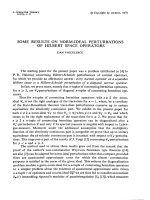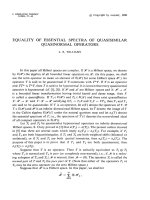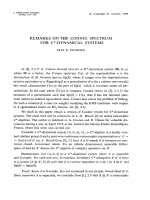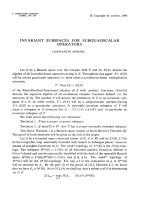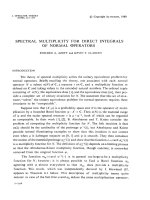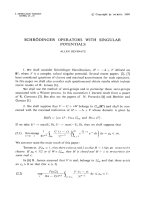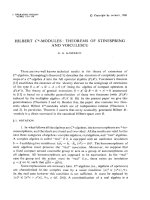Báo cáo toán học: " Balanced Gray Codes" pot
Bạn đang xem bản rút gọn của tài liệu. Xem và tải ngay bản đầy đủ của tài liệu tại đây (143.65 KB, 11 trang )
Balanced Gray Codes
Girish S. Bhat
Department of Computer Science
North Carolina State University
Raleigh, NC 27695-8206
Carla D. Savage
∗
Department of Computer Science
North Carolina State University
Raleigh, NC 27695-8206
Submitted: June 3, 1996; Accepted: August 28, 1996.
Abstract
It is shown that balanced n-bit Gray codes can be constructed for all positive integers
n.Abalanced Gray code is one in which the bit changes are distributed as equally as
possible among the bit positions. The strategy used is to prove the existence of a certain
subsequence which will allow successful use of the construction proposed by Robinson
and Cohn in 1981. Although Wagner and West proved in 1991 that balanced Gray code
schemes exist when n is a power of 2, the question for general n has remained open
since 1980 when it first attracted attention.
1 Introduction
An
n
-bit binary Gray code is an exhaustive listing of
n
-bit strings in which successive strings
differ in exactly one bit position. Alternatively, an
n
-bit binary Gray code can be viewed as
a Hamilton path in the
n
-cube and a cyclic binary Gray code as a Hamilton cycle. One such
cyclic Gray code, the Binary Reflected Gray Code (BRGC), was patented by Frank Gray
[1] as a solution to a communications problem involving digitization of analogue data. Since
∗
Supported in part by NSF grant DMS9302505
1
the electronic journal of combinatorics 3 (1996), #R25 2
then, binary Gray codes have been used in a wide variety of other applications including
databases,experimentaldesign,andpuzzlesolving[4,5,6,7,8].
As discussed, for example, in [7] the BRGC scheme, though sufficient to solve the com-
munications problem, is not adequate for certain other applications because of its lack of
“uniformity”. The term “uniformity” refers to the manner in which the bits change in the
Gray code. Several different measures of uniformity and techniques to construct Gray codes
satisfying these measures have been proposed in literature. Two such measures are the dis-
tribution of “transition counts” [2, 5, 6, 8] and the “gap” [7] of a code. Gray codes which
are uniform with respect to the former measure are referred to as balanced Gray codes.
To make this notion precise, associate with an n-bit cyclic Gray code L
n
= w
1
,w
2
, w
2
n
,
the transition sequence of bit positions s = s
1
,s
2
, ,s
2
n
,wherefor1≤ i ≤ 2
n
− 1, s
i
is
the bit position in which w
i
and w
i+1
differ and s
2
n
is the position in which w
2
n
and w
1
differ. The transition count of bit i, TC(i), in the Gray code L
n
, is the number of times i
occurs in s.
For example, the BRGC is defined by: L
1
=0, 1; and for n>1, L
n
= L
n−1
· 0,L
−1
n−1
· 1,
where ‘·’ denotes concatenation and L
−1
n−1
lists the elements of L
n−1
from last to first.
So, L
2
=00, 10, 11, 01 and L
3
= 000, 100, 110, 010, 011, 111, 101, 001. In L
n
, the transition
counts are given by: TC(n)=2andTC(i)=2
n−i
for 1 ≤ i ≤ n − 1.
A Gray code is called totally balanced if for any two bit positions i and j, TC(i)=TC(j).
A necessary condition for this to hold for an n-bit Gray code is that n is a power of 2. If
n is not a power of 2, following [2], we will call a Gray code balanced if for any two bit
positions i and j, |TC(i) − TC(j)|≤2. Thus, the BRCG is totally balanced for n =1, 2,
balanced for n =1, 2, 3, but unbalanced for n ≥ 4.
It has been an open question whether balanced Gray codes exist for all values of n.
Several techniques for construction of balanced Gray codes have been proposed. These
techniques can broadly be classified into two types. Indirect methods [6, 8] involve the
transformation of an existing Gray code to obtain one with the required properties, but
they do not guarantee balanced Gray codes. Direct methods [2, 9] involve construction of
larger Gray codes from smaller ones. The construction of Wagner and West [9], guarantees a
balanced Gray code when the number of bits, n, is a power of two. An ingenious construction
proposed in [2] produces a Gray code for all n, but balancing the code requires, for each
the electronic journal of combinatorics 3 (1996), #R25 3
n, the existence of a subsequence of the transition sequence of a balanced (n − 2)-bit Gray
code satisfying certain constraints. Robinson and Cohn claim without proof in [2] that such
a subsequence can always be found.
In this paper, we re-examine the construction of Robinson and Cohn and prove that
for each n, we can satisfy the constraints required to produce a balanced n-bit Gray code.
When n is a power of 2, the resulting Gray code will be totally balanced.
We review the construction of Robinson and Cohn in Section 2. In Section 3, we show
how to find the subsequence which can be used with the Robinson-Cohn construction to
produced balanced Gray codes for all n. Suggestions for further investigation follow in
Section 4.
2 The Construction of Robinson and Cohn
We describe the direct technique suggested by Robinson and Cohn for the construction of
balanced Gray codes. The technique is an extension of Gilberts ultracomposite method [3]
for constructing the BRGC for n-cubes by combining Hamilton cycles from two (n − 1)-
cubes.
In Robinson and Cohn’s approach, a Hamilton path for an n-cube is constructed by
combining Hamilton paths from four copies of the (n − 2)-cube. A stepwise description of
the construction is as follows.
1. Consider the transition sequence
s =(s
1
,s
2
, ,s
2
n−2
)
of an arbitrary (n − 2)-bit Gray code. Select a subsequence t =(t
1
, ,t
l
)ofs,with
l even, such that t
1
and t
2
are consecutive elements of s,asaret
l−1
and t
l
.
2. Let the four copies of the (n − 2)-cube from which the n-cube is composed be labeled
00, 01, 11, 10, according to the last two bits of their vertices. In each of the four
subcubes, consider the Gray codes defined, respectively, by the transition sequences
s
(00)
= s
(01)
= s
(11)
= s
(10)
= s. Delete transitions in the following fashion.
the electronic journal of combinatorics 3 (1996), #R25 4
1110
0100
the electronic journal of combinatorics 3 (1996), #R25 5
• From s
(00)
, delete the elements corresponding to the odd-indexed transitions
t
1
,t
3
, ,t
l−1
of the subsequence t selected in (1).
• From s
(01)
, delete the elements corresponding to t
2
,t
3
, ,t
l
.
• From s
(11)
, delete the elements corresponding to the even-indexed transitions
t
2
,t
4
, ,t
l
.
• From s
(10)
, delete just the element corresponding to transition t
1
.
3. Now connect the four subcubes as shown in Figure 2.
It can be checked that the construction described above indeed gives an n-bit Gray code.
The distribution of the transition counts in this code depends on the choice of the selected
subsequence t.IfTC
n
(i) denotes the transition count of bit position i in the n-bit Gray
code, it is clear that
TC
n
(n − 1) = TC
n
(n)=l, (1)
where l is the length of the subsequence t. Also, every transition in the subsequence t is
deleted once from two different sequences s
(ij)
. For instance, t
1
is deleted twice, once from
s
(00)
and once from s
(10)
. Therefore, if a bit position i occurs b times in t,2b transitions for
that particular bit position will be deleted. Consequently, the final transition count for bit
position i will be
TC
n
(i)=4TC
n−2
(i) − 2b, (2)
where TC
n−2
(i) is the transition count for bit position i in the (n−2)-bit Gray code defined
by transition sequence s. So if the subsequence t is chosen strategically, it may be possible
that steps 1-3 will result in a balanced n-bit Gray code. The claim of Robinson and Cohn is
that if the original (n − 2)-bit binary code is balanced, then it is always possible to choose
such a subsequence.
3 Choosing the Subsequence
In this section, we will show how to use the construction of Robinson and Cohn to produce,
for all positive integers n,ann-bit Gray code in which every bit position has transition
count either a
n
or a
n
+2.
the electronic journal of combinatorics 3 (1996), #R25 6
For n ≥ 1, let a
n
be the unique even integer satisfying
a
n
≤
2
n
n
<a
n
+2. (3)
Note that if m = 2
n
/n is even, then a
n
= m,otherwise,a
n
= m − 1.
We begin by defining certain constants associated with the construction. Let c
n
,d
n
de-
note the number of bit positions which would have transition counts a
n
,a
n
+2, respectively,
in the required Gray code. Note that the unique integers satisfying both
c
n
+ d
n
= n (4)
and
c
n
a
n
+ d
n
(a
n
+2)=2
n
(5)
are
c
n
= n − d
n
; d
n
=
2
n
− na
n
2
. (6)
Since a
n
=22
n−1
/n, d
n
is just the residue of 2
n−1
modulo n,so
c
n
> 0. (7)
In the proof of the construction, we make use of one further constant, for n ≥ 3:
k
n
=
4a
n−2
− a
n
2
. (8)
Values of these constants are shown in Table 1 for n =1, ,10.
Lemma 1 For n ≥ 7, a
n−2
≥ k
n
+2.
Proof. Using (8),
a
n−2
− k
n
− 2=a
n−2
− (4a
n−2
− a
n
)/2 − 2=a
n
/2 − a
n−2
− 2.
From (3), a
n
> 2
n
/n − 2anda
n−2
≤ 2
n−2
/(n − 2), so
a
n−2
− k
n
− 2 >
2
n−1
n
−
2
n−2
n − 2
− 3=
2
n−2
(n − 4)
n(n − 2)
− 3.
which is greater than −1forn ≥ 7. ✷
the electronic journal of combinatorics 3 (1996), #R25 7
n 2
n
a
n
k
n
c
n
d
n
1 2 2 1 0
2 4 2 2 0
3 8 2 3 2 1
4 16 4 2 4 0
5 32 6 1 4 1
6 64 10 3 4 2
7 128 18 3 6 1
8 256 32 4 8 0
9 512 56 8 5 4
10 1024 102 13 8 2
Table 1: Values of constants.
4-bit Balanced Gray Code 5-bit Balanced Gray Code
0000 00000 10111
1000 10000 10101
1100 11000 10001
1101 11100 11001
1111 11110 11101
1110 11111 01101
1010 01111 01100
0010 01110 01000
0110 00110 01010
0100 00010 11010
0101 00011 11011
0111 01011 10011
0011 01001 10010
1011 00001 10110
1001 00101 10100
0001 00111 00100
Figure 2: Balanced Gray codes for n =4, 5.
the electronic journal of combinatorics 3 (1996), #R25 8
Lemma 2 If for each n ≥ 6 we can find integers v
n
,y
n
satisfying both conditions
(A) 0 ≤ v
n
≤ c
n−2
;0≤ y
n
≤ d
n−2
and
(B) (c
n−2
− v
n
)k
n
+ v
n
(k
n
− 1) + (d
n−2
− y
n
)(k
n
+3)+y
n
(k
n
+4)=l ∈{a
n
,a
n
+2},
then for all n ≥ 1, there is an n-bit Gray code in which every bit position changes a
n
or
a
n
+2 times.
Proof. For n =1, 2, 3, the BRGC scheme gives a Gray code satisfying this property. In
Figure 2 we exhibit Gray codes for n =4, 5 in which every bit position has transition count
a
n
or a
n
+2. Let n ≥ 6 and assume inductively that an (n − 2)-bit Gray code exists with
transition sequence s = s
1
,s
2
, ,s
2
n−2 , in which every bit position occurs either a
n−2
or
a
n−2
+ 2 times. Further assume the existence of integers v
n
,y
n
satisfying conditions (A)
and (B) of the lemma. By (5), c
n−2
of the bit positions 1, ,n− 2havetransitioncount
a
n−2
and d
n−2
have transition count a
n−2
+ 2. Partition the bit positions with transition
count a
n−2
into two sets, U
n
,V
n
, of sizes c
n−2
− v
n
and v
n
, respectively. Partition the bit
positions with transition count a
n−2
+2 into two sets, X
n
,Y
n
,ofsizesd
n−2
− y
n
and y
n
,
respectively.
We claim that one can construct a subsequence t = t
1
, ,t
l
of s so that for each bit
position i ∈{1, ,n− 2}, the number of occurrences of i in t is
k
n
if i ∈ U
n
;
k
n
− 1ifi ∈ V
n
;
k
n
+3 if i ∈ X
n
;
k
n
+4 if i ∈ Y
n
;
(9)
and furthermore so that t includes the first two and last two elements of s:
t
1
= s
1
; t
2
= s
2
; t
l−1
= s
2
n−2
−1
; t
l
= s
2
n−2
. (10)
We can guarantee that (9) is satisfied if, when i ∈ U
n
∪ V
n
,
TC
n−2
(i)=a
n−2
≥ k
n
and otherwise, if i ∈ X
n
∪ Y
n
,
TC
n−2
(i)=a
n−2
+2≥ k
n
+4.
the electronic journal of combinatorics 3 (1996), #R25 9
Note from Table 1 that for n =6,d
n−2
= 0, so that only a
n−2
≥ k
n
need be satisfied, which
it is. For n ≥ 7, we have a
n−2
≥ k
n
+ 2 by Lemma 1. To see that (10) can be satisfied as
well, note that no bit position appears more than twice among {s
1
,s
2
,s
2
n−2
−1
,s
2
n−2 }. It
can be checked from (3), (8), and Table 1 that for n ≥ 6, we have k
n
≥ 3. Thus, each bit
position is required by (9) to appear at least k
n
− 1 ≥ 2 times in the subsequence t.So,
there is no difficulty in arranging for t tosatisfy(10)aswellas(9),asclaimed.
We henceforth assume that t has been chosen to satisfy (9) and (10). By condition (B),
t has length l ∈{a
n
,a
n
+2}. Now, from the sequences s and t,usetheconstructionof
Robinson and Cohn to construct an n-bit Gray code. By (1) and (2), in the resulting Gray
code, the transition counts of the bit positions are given by
TC
n
(i)=
4a
n−2
− 2k
n
= a
n
if i ∈ U
n
4a
n−2
− 2(k
n
− 1) = a
n
+2 if i ∈ V
n
4(a
n−2
+2)− 2(k
n
+3)=a
n
+2 if i ∈ X
n
4(a
n−2
+2)− 2(k
n
+4)=a
n
if i ∈ Y
n
l ∈{a
n
,a
n
+2} if i ∈{n − 1,n},
(11)
which are all in {a
n
,a
n
+2}. It is straightforward to confirm that
n
i=1
TC
n
(i)=2
n
. ✷
It remains to show that the hypotheses of Lemma 2 can be satisfied.
Theorem 1 For al l n ≥ 1,thereisann-bit Gray code in which every bit position changes
a
n
or a
n
+2times.
Proof. This is clear for n =1, 2, 3 and, from Figure 2, for n =4, 5. For n ≥ 6, we show
that there exist integers v
n
,y
n
satisfying both (A) and (B) of Lemma 2.
Condition (B) simplifies via (6) and (8) to
a
n
+ d
n
− d
n−2
− v
n
+ y
n
∈{a
n
,a
n
+2}
which is equivalent to
d
n−2
+ v
n
− y
n
∈{d
n
,d
n
− 2}. (12)
To satisfy condition (A), we are free to select v
n
∈{0, 1, ,c
n−2
} and y
n
∈{0, 1, ,d
n−2
}.
Thus, d
n−2
+v
n
−y
n
can assume any integer value in the closed interval [d
n−2
−d
n−2
,d
n−2
+
c
n−2
]=[0,n− 2]. It remains to show that either d
n
or d
n
− 2 lies in this interval, but this
follows immediately from 0 ≤ d
n
≤ n − 1.
Specifically, v
n
and y
n
canbechosenasfollows:
the electronic journal of combinatorics 3 (1996), #R25 10
• If d
n−2
≥ d
n
then set v
n
=0andy
n
= d
n−2
− d
n
;
• otherwise, if c
n−2
+ d
n−2
− d
n
≥ 0thensety
n
= 0 and v
n
= d
n
− d
n−2
;
• otherwise, set y
n
= 0 and v
n
= d
n
− d
n−2
− 2.
In each case, it can be checked that (12) is satisfied and that v
n
∈{0, 1, ,c
n−2
} and
y
n
∈{0, 1, ,d
n−2
}.Weusethefactthatc
n
> 0from(7),so
c
n−2
+ d
n−2
− d
n
= n − 2 − d
n
= c
n
− 2 ≥−1
Thus, if neither of the first two cases hold,
d
n
− d
n−2
= c
n−2
+1≥ 2.
✷
We note that the last case in the proof of Theorem 1 can occur only if n − 2 − d
n
= −1,
that is, only if the residue of 2
n−1
modulo n is −1. We suspect that this never happens for
n ≥ 1.
Notefrom(3)and(6)thatwhenn is a power of 2, d
n
= 0, so the Gray code of our
construction is totally balanced. This gives an alternative to the construction of [9] when
n is a power of 2.
Corollary 1 For al l n ≥ 1,ifn is a power of two, the construction of Lemma 2 and
Theorem 1 gives an n-bit Gray code in which every bit position changes 2
n
/n times.
4ConcludingRemarks
Is it possible, for all n, to construct a Gray code in which, for any bit positions i and j,
|TC(i) − TC(j)|≤1? Another problem, suggested by one of the referees, is to determine
under what conditions a given partition of 2
n
− 1inton positive integers can represent the
transition counts of a Gray code (or, a partition of 2
n
into n even integers for a cyclic Gray
code.)
Acknowledgement We are most grateful to the referees for their many suggestions and
insights to improve the presentation of this paper. In particular, one of the referees con-
siderably simplified the proof of the main theorem and the other referee contributed Figure
the electronic journal of combinatorics 3 (1996), #R25 11
1, a more illuminating alternative to the one in the original version of this paper. The
second author would like to thank Luis Goddyn for introducing her to this problem and for
generously sharing his ideas.
References
[1] F. Gray, PulseCodeCommunication, U.S Patent No. 2632058 (March 15,1953).
[2] J. Robinson and M. Cohn, Counting Sequences, IEEE Trans. Comput. C-30 (1981)
17-23.
[3] E.N. Gilbert, Gray Codes and Paths on the n-Cube, Bell System Technical Journal,
Vol. 37 (1958) 815-826.
[4] M. Gardner, The Curious Properties of the Gray Code and How it Can be Used to
Solve Puzzles, Sci. American, 227 (1972) 106-109.
[5] J.E. Ludman, Gray Code Generation for MPSK Signals,IEEETrans.Commun.,COM-
29 (1981) 1519-1522.
[6] J.E. Ludman and J.L. Sampson, A Technique for Generating Gray Codes, Journal of
Statistical Planning and Inference, 5 (1981) 171-180.
[7] L. Goddyn, G.M. Lawrence and E. Nemeth, Gray Codes with Optimized Run Lengths,
Utilitas Mathematica, 34 (1988) 179-192.
[8] V. E. Vickers and J. Silverman, A Technique for Generating Specialized Gray Codes,
IEEE Trans. Comput. C-29 (1980) 329-331.
[9] D.G.Wagner and J. West, Construction of Uniform Gray Codes, Congressus Numer-
antium, 80 (1991) 217-223.
